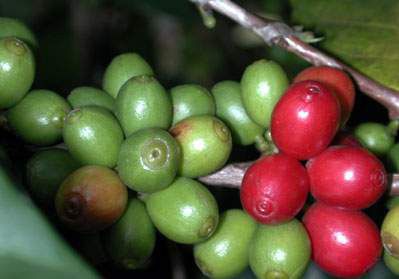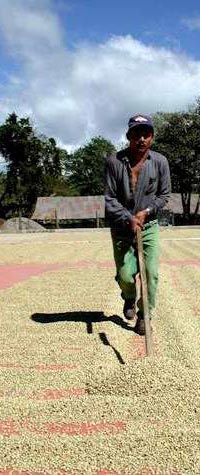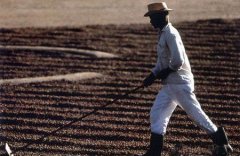The processing process of coffee berries picking-berry treatment-drying
The coffee beans we are talking about are actually the seeds of a fruit similar to cherries. Coffee trees produce berries, called coffee berries, whose bright red color means they are ripe and ready to be picked. The fruit clustered on the branches. The outer skin (exocarp) of coffee berries is thick and bitter. However, the fruit (mesocarp) inside is very sweet and has the texture of grapes. Then there is parenchyma, a sticky film like honey that protects coffee beans. The coffee beans themselves are also covered with a parchment-like coating called endocarp. It protects two turquoise coffee beans, of course, with a thin film called seed coat or silver coat.

Coffee is usually harvested once a year. The harvest time depends on the geographical location, but usually the northern hemisphere harvests from September to March, while the southern hemisphere harvests from April to May. Coffee is usually picked by hand and can be picked off all the berries from the branches at once or selectively. The latter method is expensive and only suitable for picking Arabica coffee beans.

The next step after picking is to deal with it. There are two ways to handle it:
Sun drying-the simplest and most economical way, the coffee berries picked are placed directly in the sun and spread out to dry. Then turn it continuously with a rake and let it dry for 7 to 10 days until the moisture content is reduced to 11%. The outer skin of the coffee berry will turn yellow and the coffee beans inside will shake.

Water-wet-the main difference between sun-drying and water-wet is that the pulp of coffee berries must be removed from coffee beans within 24 hours of picking. The skin and pulp can be washed off with a pulp washer. The coffee beans are then placed in the fermentation box for 12 to 48 hours. The natural enzyme removes the sticky material from the parchment wrap. Then, the coffee beans are either dried in the sun or dried by a machine.


After the coffee beans are dried, all the coating is peeled off from the coffee beans (a process called peeling). Occasionally, a machine specially designed to peel off the remaining silver skin is used. Then, according to the size and specific gravity, the coffee beans are classified and classified. Coffee beans are either sorted by hand on the conveyor belt, or the light (defective) and heavy ones are separated by a blower.
The coffee shipped is unroasted. It's called green coffee. It is generally stored in jute or Bohr sacks or shipped in large plastic freight containers. As many as 7 million tons of green coffee are shipped around the world every year.
Important Notice :
前街咖啡 FrontStreet Coffee has moved to new addredd:
FrontStreet Coffee Address: 315,Donghua East Road,GuangZhou
Tel:020 38364473
- Prev

What are the processing methods of coffee beans? Drying method
Sun-dried coffee beans [Pirajui in Sao Paulo, Brazil] there are two ways to prepare coffee beans for roasting. The method chosen has a significant impact on the final price and quality of coffee. The cheapest method of processing is called drying, which is used for lower-grade coffee beans, while higher-quality coffee beans are processed by wet treatment.
- Next

Analysis on the skills of initial processing and roasting of Coffee
The harvest time is different in different countries and regions. The harvest process requires a lot of manpower, especially high-quality selected coffee, which can only pick fully ripe red coffee cherries. Because all coffee cherries don't ripen at the same time, you need to go back to the same tree many times to pick. Coffee beans come from a mature seed called coffee cherry (cherries).
Related
- What is the meaning of lactic acid fermentation with coffee bean treatment?
- How to judge the state of foam by sound?
- How does the latte pull out the unicorn pattern? Come to get for a little trick to improve the flower pull!
- Will flower pulling affect the taste of the latte?
- Do you know the history of coffee?
- The difference between honey treatment and sun washing what is raisin honey treatment?
- What kind of milk can a novice use to make coffee foam to keep the foam longer? The correct method and skills of milking tutorial sharing
- Why do washed coffee beans taste sour? Flavor characteristics of washed Coffee
- Introduction to the skill of how to practice the size and height of water injection around the circle of hand-brewed coffee
- How do beginners practice coffee flower drawing from scratch?

